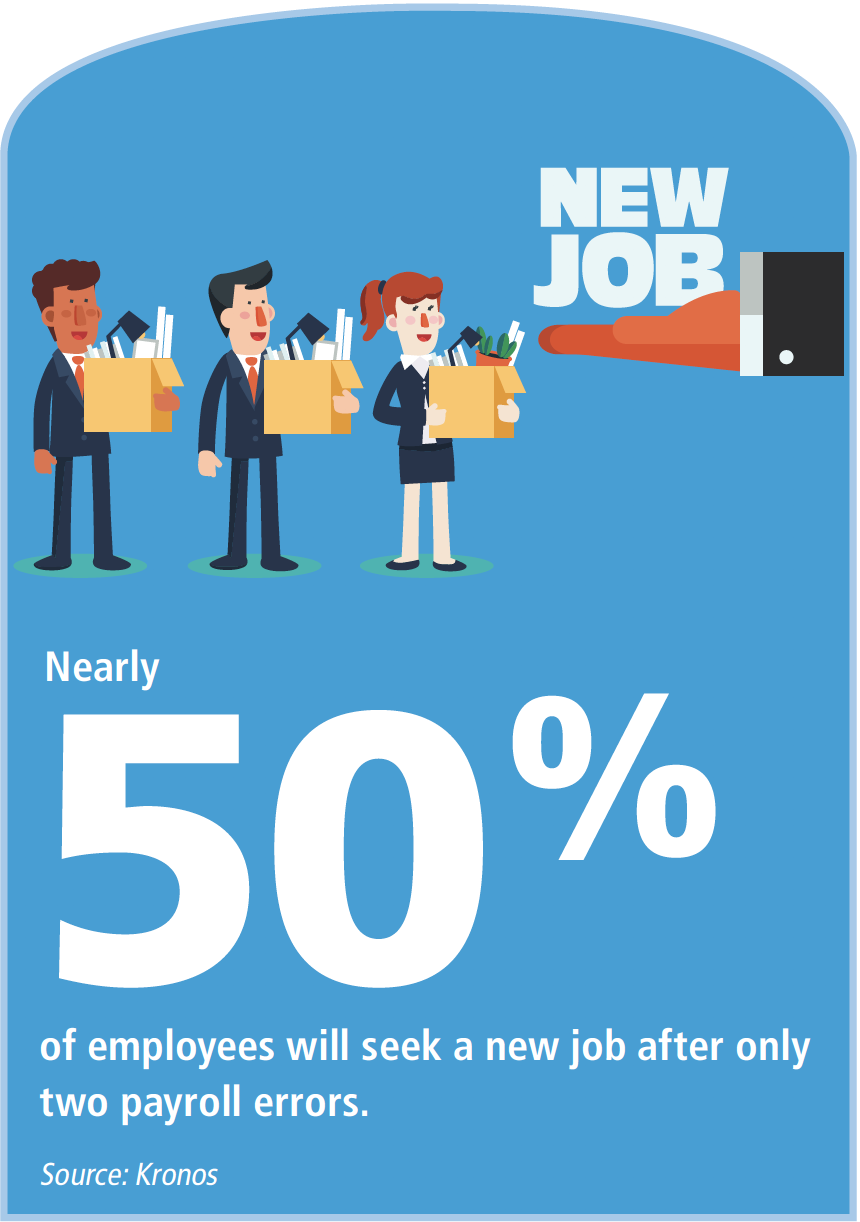Implement these seven best practices to improve the quality and accuracy of the payroll process.
By Imran Sajid
It has always been important to pay employees in a timely and accurate manner. Being one day late or 99 percent accurate isn’t good enough. With the world more connected and impatient than ever before, it is critical for successful organizations to pay people accurately and on time. In the digital age, issues that previously stayed behind closed doors are visible for the entire world to read about, which can result in serious ramifications. The last thing HR professionals want is employees and former employees submitting Glassdoor reviews about how their organization consistently made mistakes on payday. The value of a brand is very significant and any loss of business reputation can be costly.
If an organization frequently has payroll issues, it may also experience high turnover, which can create a lasting financial impact. Research from Bonusly has determined that companies with 500 employees and an average annual salary of $65,000 that lose 90 employees per year to turnover have an annual employee turnover cost of just over $3 million. Another impactful statistic from a recent Engaging Employees Through Payroll study by Kronos found that nearly 50 percent of employees will seek a new job after only two payroll errors, with salaried employees more likely than hourly employees to look for new opportunities. And the best, brightest, and most expensive people to replace are typically the first ones out the door due to things like payroll issues.

The Kronos study specifically looked at differences between generations on people’s tolerance for payroll errors and found that 44 percent of American employees over 55 say they would stay at their job after a payroll mistake as long as they are eventually paid correctly. That’s in stark contrast to their younger colleagues aged between 18 and 29 (13 percent); 30 and 39 (17 percent); and 40 and 54 (27 percent), who are much less willing to stay, even if the error is eventually corrected.
Given the ramifications of poor payroll strategy, HR professionals should focus on the following seven areas to improve their payroll process and become a top-performing organization:
1. Continuously audit payroll. Many organizations still have practices in place that are focused on checking payroll data right before it runs, making it difficult to ensure accuracy. These organizations are constantly under extreme pressure because they may have more than 20 audit reports to run right before payroll to help identify and fix discrepancies. This causes anxiety and errors, especially when there is not enough time to investigate or get a question answered when someone is out of the office. Many of these organizations have been running payroll this way for more than 20 years without ever changing the process and they have a tough time grasping how they could get ahead of payroll with proactive auditing.
Instead of operating this way, organizations should have continuous payroll auditing beginning on the first day of a new payroll period. These audits should be focused on the data that goes into payroll, but also on simulating how that data will be calculated to avoid surprises. The more proactive an organization is, the more accurate its payroll will be, and the payroll department will be much happier without the frequent fire drills every time payroll is being run.
2. Improve internal communication across the organization. Constant communication with people across the organization who have a part in payroll accuracy is critical. To get this right, there must be a conscious effort to get people on the same page.
For example, an organization upset employees by making careless errors when distributing bonus payments that people were counting on for their holiday shopping. The direct result of this was higher than normal employee turnover. Realizing that this could have been avoided if the payroll team had open lines of communication with the HR staff working on compensation during the period when raises or bonuses were given, the organization has since put a new communication structure in place.
3. Revisit outdated processes. There are many companies that have the same HR and payroll system they first went live with, which in many cases was about 15 to 20 years ago. There are simply better ways to do things now than there were in 1999 or even 2009, and updating systems can provide real business value to ensure a more accurate payroll.
For example, one SAP SuccessFactors customer uses a different system for time and attendance management than payroll. The organization receives an interface file once a week containing all of its time and attendance data, right before payroll. This makes it nearly impossible for the payroll department to proactively audit time management-related calculations. This client built many audits in its time and attendance system to ensure accuracy, but still ran into discrepancies.
Modern technology provides easy access to data with APIs instantly, so essential payroll-related information should not be flowing in right before payroll. Organizations should look at the whole chain of information needed to run payroll and to work closely with their data providers to check for opportunities to increase efficiency.
4. Focus on continuous improvement. Whenever a payroll issue occurs, a few questions should be considered: What can be done to prevent this from happening again? Is there an audit check that can be added to the system? Should there be a process change? Some organizations are quick to point fingers and place blame, but that is not a productive or helpful response. It is much more effective to fix the issue as best as possible and then focus on continuous improvement to prevent the same problem twice.
For example, one company always pays severance within 30 days of an employee leaving. Recently, it had an issue where an employee was terminated but was still being paid beyond the 30-day window for many months, resulting in a substantial loss for the company. To ensure this never happened again, it created an audit process to check for employees who have been terminated for more than 30 days and are still being paid.
5. Keep it simple. Some organizations create huge employee handbooks filled with rules and guidelines which get longer and longer over the years. It’s important to remember that there is such a thing as over-control. In some occasions, process simplification might be a better approach.
One company had a very hard time getting its employees to submit their timesheet data in a timely manner, which caused headaches for its payroll department. The HR team tried to ensure that employees would submit their timesheets by making every manager accountable, including disciplinary action for noncompliance. But then they asked themselves a few simple questions: How easy is it for employees to enter their time? Can it be done via mobile? Is it an intuitive process that new employees can easily figure out? This allowed them to identify the crux of the problem and develop a solution.
Organizations will get much further with motivating employees by making things easier and providing intuitive tools rather than ruling with an iron fist or a huge employee handbook.
6. Automate manual processes. Manual processes can be cumbersome and increase the risk for data errors because of the possibility of keying errors. For example, an organization was using a legacy system that required manual calculations to enter retroactive changes into the system. This organization used an Excel spreadsheet with formulas to do the calculation and then entered that data manually into its payroll system. While its payroll team had strict rules in place to limit the impact as much as possible, it was an area with a lot of pain and one they were really looking forward to automating.
HR leaders should take any processes that can be automated and put them into their HR and payroll system rather than manually calculating from a spreadsheet.
7. Track results. If a company is serious about ensuring payroll accuracy, it should track metrics to see if it is improving or regressing. One organization recently wanted to improve employee perception and optimize its payroll operations. It started by tracking total employee issues reported each month and the number of off-cycle payrolls it ran. It also set targets for improving the employee experience by having fewer issues and for operational efficiency by running fewer off-cycles. The metrics helped the organization focus on improving over time. Ultimately, this company was able to reduce payroll queries by 50 percent and reduce the need for off-cycle runs by almost 40 percent, resulting in a huge time savings for its payroll staff every month.
The New Business Reality
The very clear reality is this: If an organization struggles with payroll accuracy and nothing is done to combat the issue, it shouldn’t expect the problem to stay the same because it will almost definitely get worse. If the company cannot keep quality people because of payroll delays or inaccuracies, or it cannot bring in top talent because of a tarnished reputation, business success will be nearly impossible. Implementing these seven best practices is a good start when it comes to improving the employee experience and bettering the organization’s turnover rate.
Imran Sajid is director of human capital solution management at SAP SuccessFactors.














